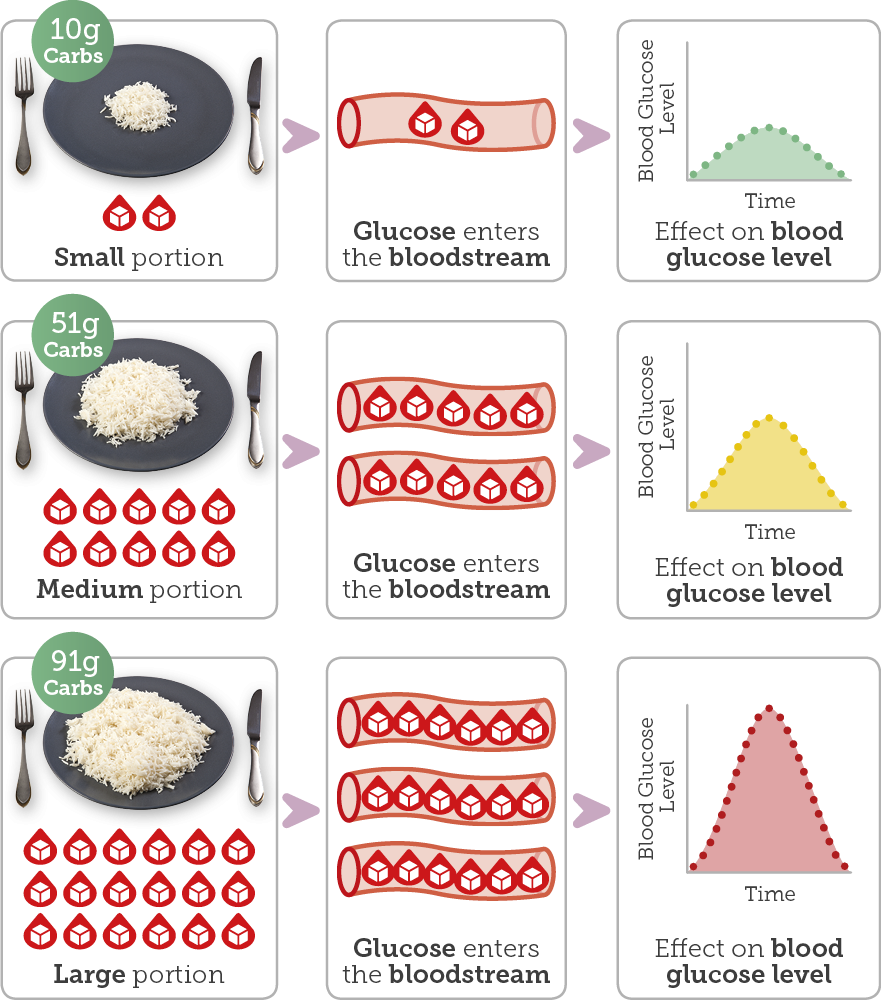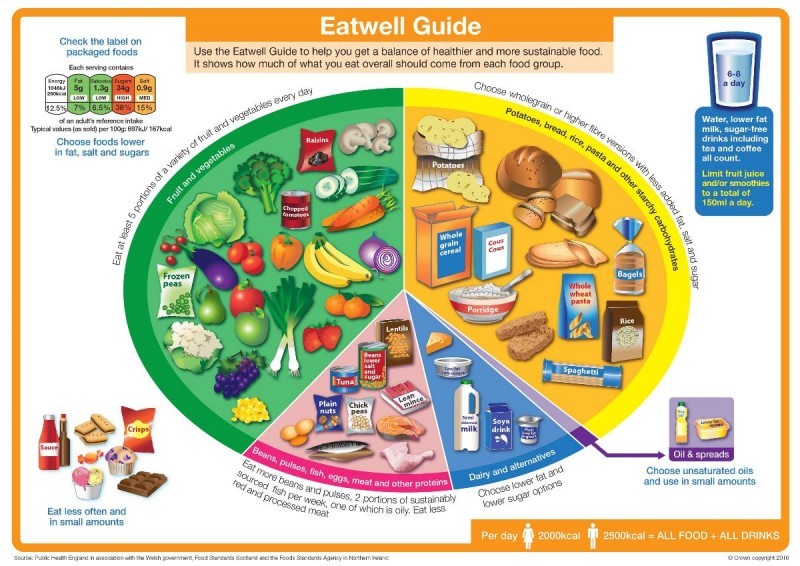Diet: Key Information for Healthy Eating
Contents
Introduction
Whether living with a health condition or not, a healthy, well-balanced approach to eating and drinking is important.
The foods you choose to eat will play an important role in helping you control your weight and reducing the risk of long-term conditions such as heart disease, type 2 diabetes, stroke and certain cancers.
Here are some tips for healthy eating:
Regular meals
Key message: aim for three meals each day and avoid skipping meals
Your food and drink intake should be based on regular meals with a good mix of nutrients and sensible portion sizes. By eating regularly, you keep your blood glucose levels steady, energy levels up and curb cravings for high-calorie snacks, which should be limited in a healthy diet.
Starchy carbohydrates
Key message: include a starchy carbohydrate at each meal (unless you are on a carbohydrate limiting diet), especially ones that are rich in fibre and whole grains
Starchy carbohydrates are foods such as pasta, rice, potato, bread, chapatis and plantains.
 You should choose starchy carbohydrates which contain higher levels of fibre and whole grains and have a lower glycaemic index. These are digested more slowly and can help to keep you feeling fuller for longer, so they can help you with weight loss too.
You should choose starchy carbohydrates which contain higher levels of fibre and whole grains and have a lower glycaemic index. These are digested more slowly and can help to keep you feeling fuller for longer, so they can help you with weight loss too.
Do not eat any more than one type of carbohydrate with every meal.
Sugary carbohydrates
Key message: limit added sugar to 30 g (6 tsp a day) a day
It is possible to enjoy a small amount of sugar as part of an overall balanced approach to eating, but it is best to limit sugary foods and drinks where possible. Switching to artificial sweeteners and sugar-free options can help.
Fruit and vegetables
Key message: aim for at least five portions of fruit and vegetables each day
Fruit and vegetables are good sources of fibre and are packed with essential vitamins and minerals. You should eat a wide variety and aim for a minimum of five portions each day – two or three fruits and at least two or three vegetables. This can help to reduce your risk of developing many health conditions such as high blood pressure, heart disease, stroke, obesity, type 2 diabtees and certain cancers.
An added bonus is that most fruits and vegetables are naturally low in calories and high in fibre, which will help you to maintain a healthy weight.
Fresh, frozen, dried and canned fruit and vegetables (canned in fruit juice or water and with no added sugar and salt) all count.
Limit fruit juice, vegetable juice, and smoothies to a combined total of 150ml per day. Crushing fruit and vegetables into juice releases sugars that can harm teeth, so enjoy them at mealtimes rather than between meals to reduce the risk of tooth decay.
Salt
Key message: aim for no more than 6 g (1 tsp) salt each day
Eating too much salt can raise your blood pressure, particularly if you are overweight or if high blood pressure runs in your family. This is concerning, as high blood pressure increases the risk of developing heart disease.
Avoid adding salt to your meals and reduce the amount of salt you use in cooking. Choose fresh foods where possible as processed foods usually have a high salt content. Soups, crisps, savoury snacks, soy sauce, Marmite, gravy granules and stock cubes are all high in salt. Experiment with flavouring foods using herbs and spices, vinegar or lemon juice instead of salt and stock cubes.
Alcohol
Key message: drink no more than 14 units per week, with alcohol-free days
The risk of developing a range of health problems, including high blood pressure and diseases such as certain cancers, increases if you consistently drink more alcohol than the recommended amounts.
However, having diabetes does not mean that you need to avoid drinking alcohol altogether:
- Men and women are advised not to drink more than 14 units a week on a regular basis
- Spread your drinking over 3 or more days if you regularly drink as much as 14 units a week
- If you want to cut down, try to have several drink-free days each week
Remember that alcohol is high in calories and can contribute to weight gain.
Omega 3 fatty acids
Key message: aim to eat two portions of oily fish each week
Omega 3 fats are a type of healthy fat called an essential fatty acid. Your body cannot make these in sufficient amounts, so you have to get them through food. They can lower blood triglycerides (a type of fat found in the blood) and help protect against heart disease.
Omega 3 fats are found mostly in oily fish such as mackerel, salmon, herring and sardines, so you should try to eat these twice a week.
Fats
Key message: aim to reduce total fat intake, whilst also replacing saturated fats with unsaturated equivalents
To achieve or maintain a healthy weight, it is important that you reduce the total amount of fat you eat, as all oil has the same number of calories, whether it is a healthy type or not. You should always measure the oil you use in cooking with a teaspoon rather than pouring it straight from the bottle, or use an oil spray instead.
You should try to replace saturated fats with moderate amounts of healthier fats:
- Monounsaturated fats, found in olive and rapeseed oils and spreads
- Polyunsaturated fats, found in soya, sunflower and corn oils and spreads, nuts, seeds and oily fish
Eating these types of fat can help reduce your risk of developing heart disease.
Healthy weight
Key message: staying at a healthy weight will help reduce your risk of developing many health conditions
If you are overweight, you may need to reduce the size of the portions of food you eat and aim for a better overall balance between the different food groups. Almost two in every three adults in the UK are overweight or obese, which can cause significant health problems.
Living with overweight and obesity can also affect your quality of life, self-esteem and contribute to mental health problems, such as depression.
Exercise
Key message: aim to increase your daily activity levels
To stay healthy, you should aim for 30 minutes of active exercise five times a week. This should include moderate aerobic exercise (such as cycling or brisk walking) and strength exercises that work most of the major muscle groups (such as Pilates or weights) at least twice a week.
Useful resources
No one food group can give you all the energy and nutrients your body needs to stay healthy. Eating a balanced diet means that you eat foods from all the main food groups but less of some foods and more of others.
The Eatwell Guide divides the foods and drinks we consume into 5 main groups:
- Fruit and vegetables
- Potatoes, bread, rice, pasta and other starchy carbohydrates
- Beans, pulses, fish, eggs, meat and other proteins
- Dairy and alternatives
- Oils and spreads

You may not achieve the balance with every meal but you should try to work to these proportions over the day or week so that you get the variety of nutrients that your body needs.
Some people have found that a Mediterranean style diet which reduces their carbohydrate portion to a quarter of the plate is helpful for weight loss. You can increase the portion of vegetables or salad on your plate to compensate for the reduced carbohydrate.
To learn more about losing weight, click here.
For more information on exercise, click here.



